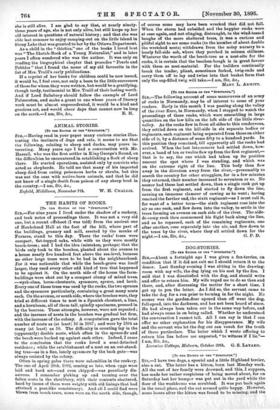THE HABITS OF ROOKS.
[To THE EDITOR OF THE " SPRCTATOR:] Sin,—For nine years I lived under the shadow of a rookery, and took notes of proceedings there. It was not a very old one, but a recent offshoot (I was told) from the ancient one of Hankshead Hall at the foot of the hill, where part of the buildings, granary and mill, erected by the monks of Farness, stand to this day. There the rooks' trees were compact, flat-topped oaks, while with us they were mostly beech-trees ; and I had the idea (mistaken, perhaps) that the birds only took to the beeches, planted about the avenue to a house nearly five hundred feet above the sea-level, because no other large trees were to be had in the neighbourhood- For it was noticeable that while the beech-grove was itself larger, they used every other odd kind of tree that happened to be against it. On the north side of the house the farm- buildings were shut out by a compact clump of mixed trees, —wych-elms, horse-chestnuts, sycamore, spruce, and larch. Every one of these trees was used by the rooks, the two spruces and the sycamore particularly, containing a great many nests each. On the avenue, or south side, where the beeches were, they tried at different times to nest in a Spanish chestnut, a lime, and a hornbeam, all of them tall, spindly specimens, pressed in by the beeches. These attempts, however, were not repeated ; and the increase of nests in the beeches was gradual but firm, with the increase of the colony. A computation gave the total number of nests as (at least) 16 in 1887; and were by 1894 as many (at least) as 50. The difficulty in counting lay in the (apparently) double nests, which often in the spruce-fir and
the beech were backed up against each other. Indeed, I came to the conclusion that the rooks loved a semi-detached residence ; while the establishment of a nest on an out-stand- ing tree—as in a fine, lonely sycamore by the back gate—was always resisted by the colony.
Often in spring gales there were calamities in the rookery. The one of April 28th, 192, coming so late, when eggs were laid and hard set—and even chipped—was peculiarly dis- astrous. I remember picking up and turning over the fallen nests in the shrubbery, with their contents shattered, hard by (some of them were weighty with old linings that had attained a peat-like consistency). And all I could find were blown from beech-trees, none were on the north side, though, of course some may have been wrecked that did not falL When the storm had subsided and the happier rooks were at ease again, and not clinging, distraught, to the wind-tossed boughs of the more sheltered trees, it was a curious and pitiful sight to see some rooks (to the number of about double the wretched nests) withdrawn from the noisy nursery to a lonely fell-side ash, where they perched in solemn stillness. Whatever the worth of the beech-tree as a nest-site for the rooks, it is certain that the beechen-bough is in great favour with them as nest-material. For the builders continually break the tender, pliant, sometimes forked, twig-ends and carry them off to lay and twine into that basket form that only the sap-filled twig will take.—I am, Sir, &a.,
MART L. ARMITT.










































 Previous page
Previous page